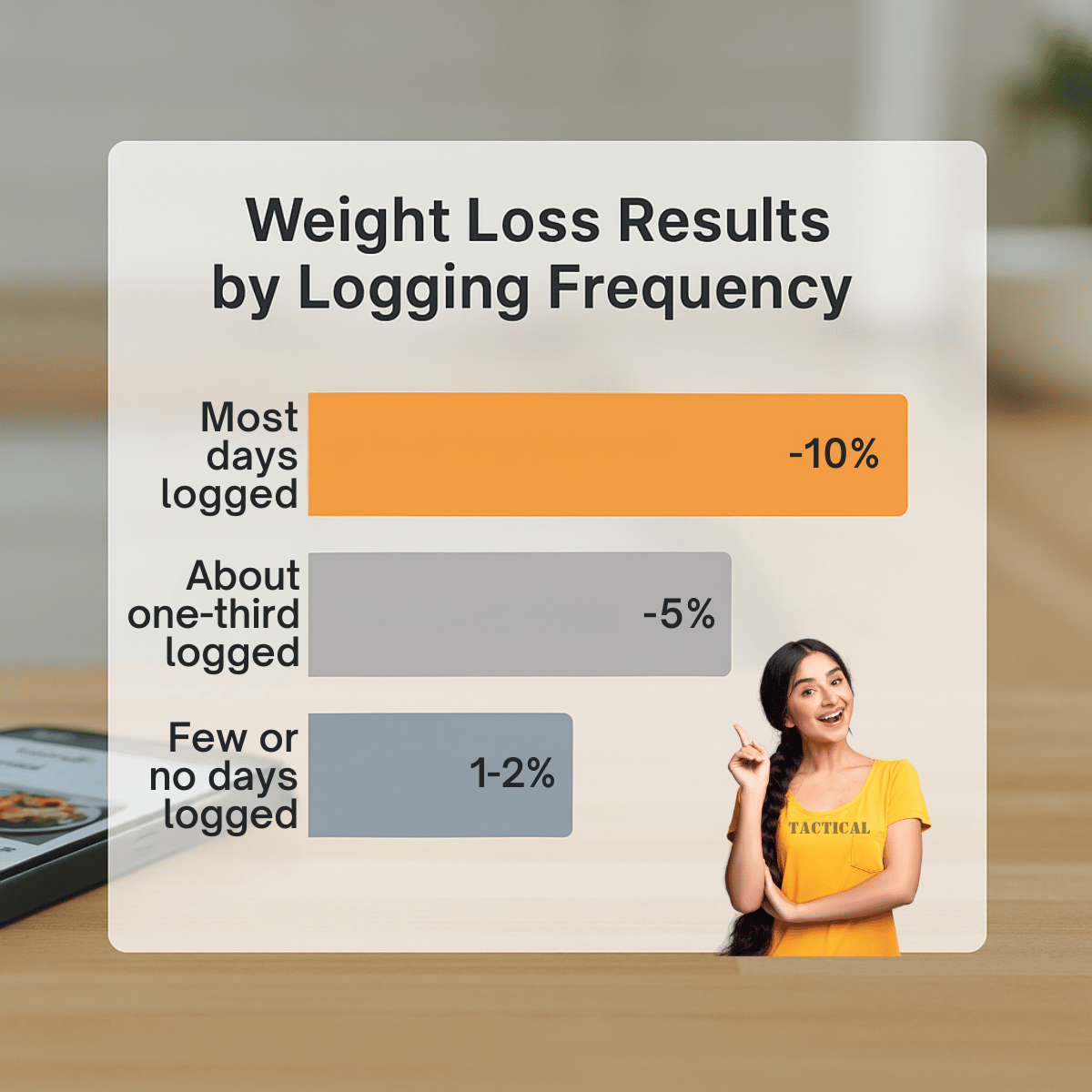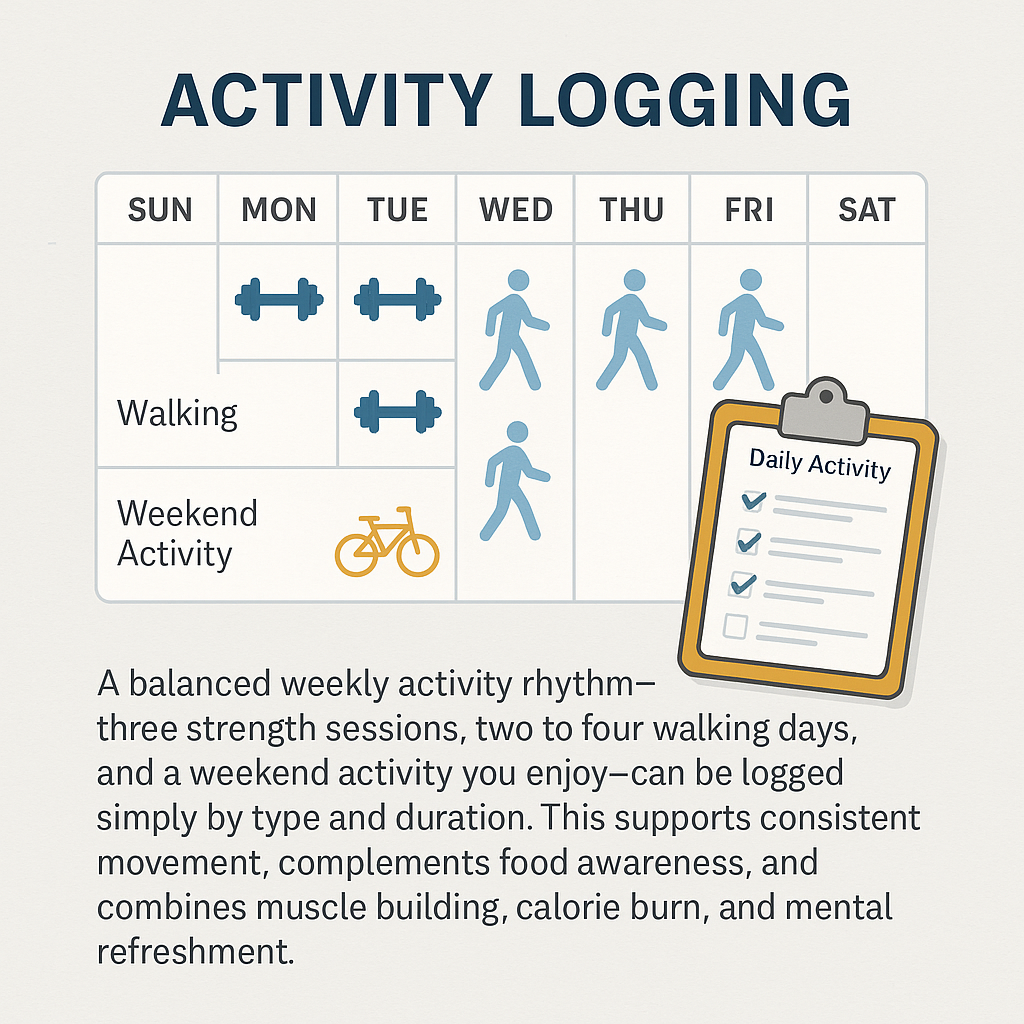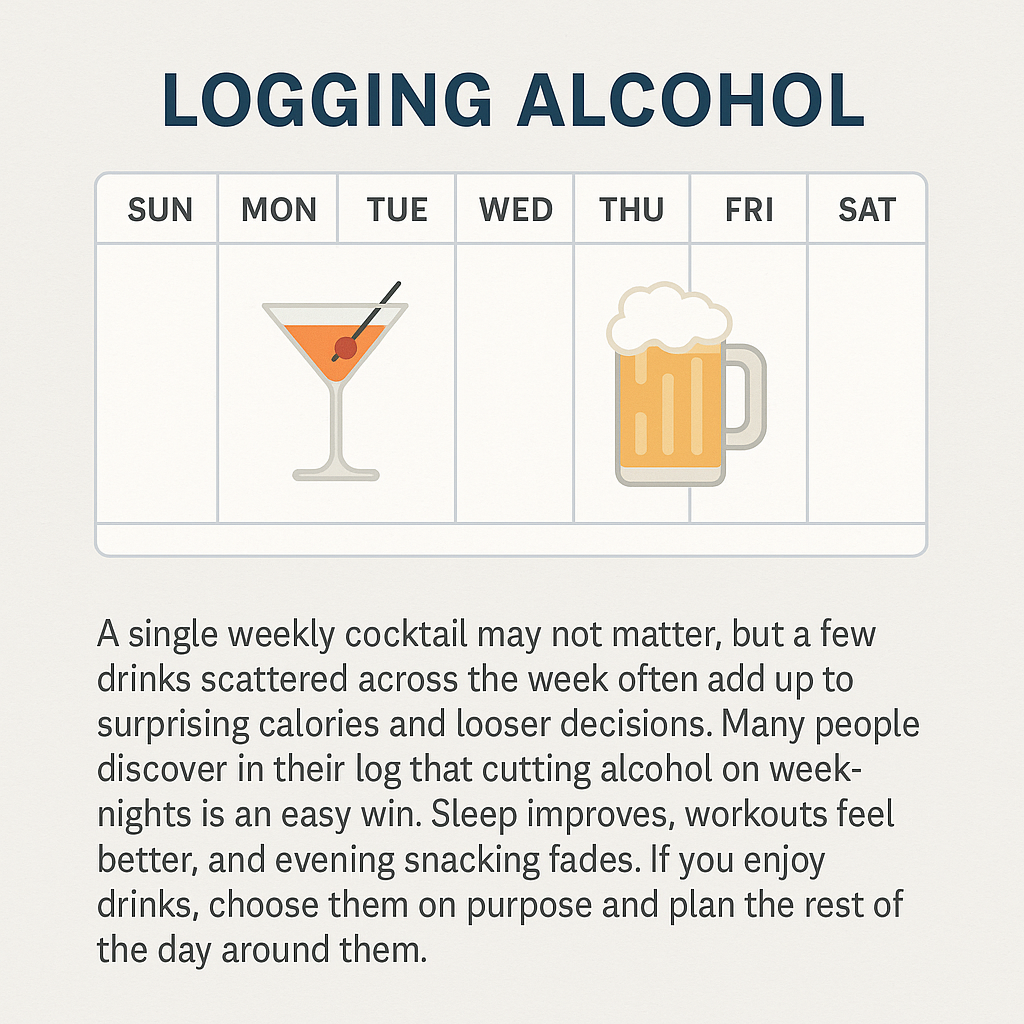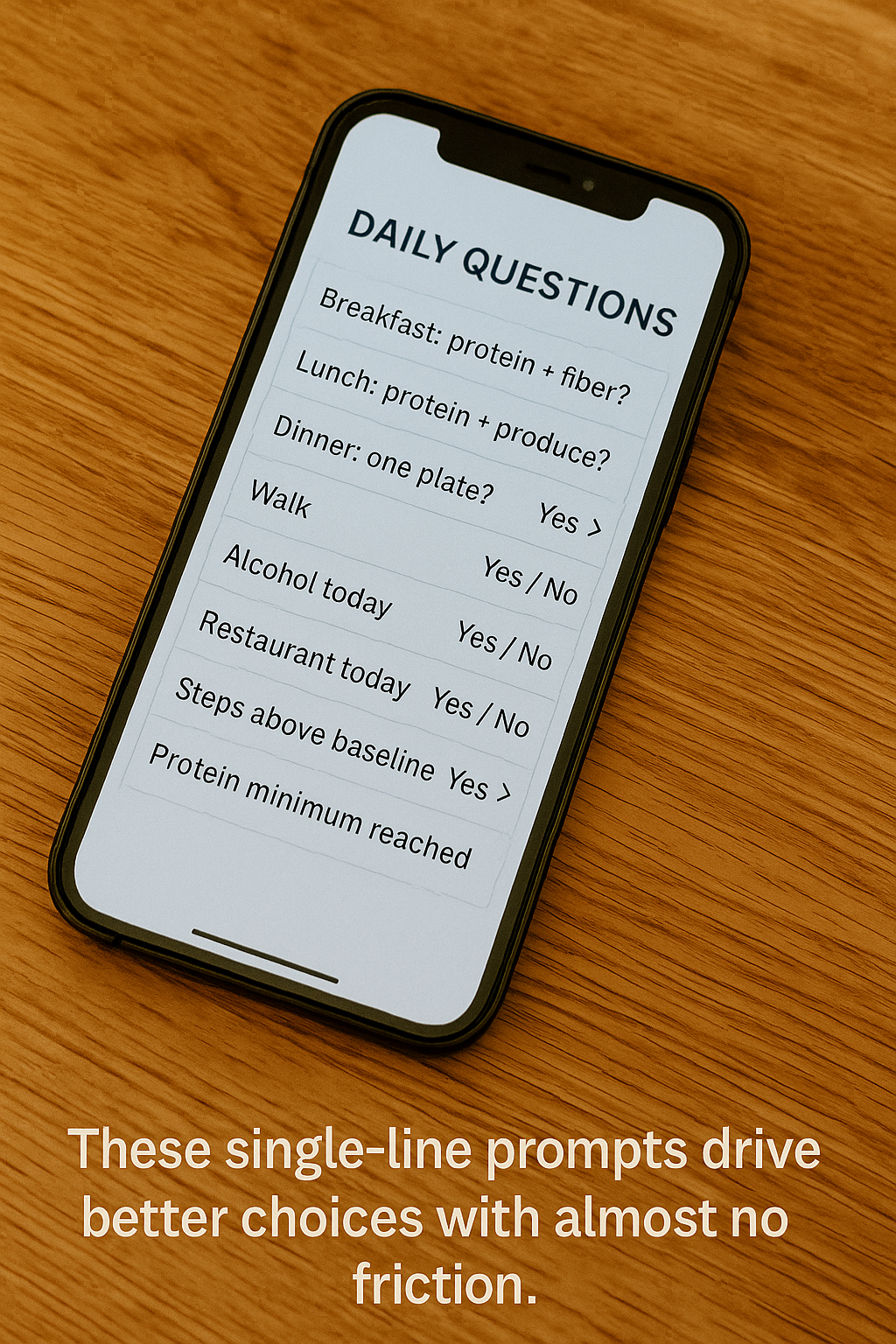Tracking for Real-World Weight Loss
How Food and Fitness Logs Drive Results
If you have ever downloaded a tracking app with the best intentions, logged breakfast, nailed lunch, and then "forgot" dinner, you are not alone. Many of us have wrestled with weight loss, bounced between plans, and wondered why progress stalls even when we try. Here is the encouraging part: tracking what you eat and how you move can make a real difference even when it is imperfect. You do not have to count every gram forever. You do not have to be perfect to succeed. You just need a simple system you can repeat most of the time.
The Hypothesis We Are Testing
The idea is straightforward: people who track more accurately and more consistently tend to get better results. That does not mean obsessive logging or perfection. It means honest, repeatable habits that keep you aware of what you are doing. The claim shows up in research and, just as importantly, in the stories of thousands of people who finally felt in control once they could see their patterns clearly.
Two Cornerstone Sources You Can Read Yourself
You can explore an academic look at digital self-monitoring and weight change in the journal Obesity here: Obesity study link. You can also read a plain-language summary from Duke University on why simple, consistent food tracking predicts weight loss: Duke news link. When you piece these together, you get a practical message: track often enough to stay honest, and your weight is likely to move in the right direction.
Why Tracking Works Even If You Are Not a Spreadsheet Person
Awareness is powerful. Most weight loss stalls live in the gap between what we think we do and what we actually do. A small pour of cereal that is really two servings. A tablespoon of peanut butter that is really three. A "light" lunch that was 900 calories. Without tracking, the brain rounds down calories and rounds up effort. With tracking, the fog lifts. You do not need to judge yourself; you only need to see clearly. That clarity changes decisions. When you see the afternoon snack pattern, you start packing protein. When you notice weekends undo the weekday deficit, you plan a steadier Saturday. When you see that dining out spikes calories, you adjust earlier in the day or pick a different entrée. Tracking is not a diet. It is a mirror.
But I Hate Logging Every Bite
Totally fair. The goal is not eternal, rigid logging. The goal is a practical level of self-monitoring that works in your actual life. Think of tracking as an accountability dial, not a switch. You can turn it up during fat-loss phases, down during maintenance, and back up after holidays. Even partial tracking helps, because it keeps you anchored to reality. If you track breakfast and lunch on most days, dinner choices improve. If you weigh yourself a few times each week and log a short summary of meals, your awareness stays high. Perfection is not required; presence is.
The Pattern That Shows Up Again and Again

When researchers look at digital programs, a consistent pattern appears. People who log more days make more progress. People who log less still make some progress, but not as much. People who stop logging tend to stall. Crucially, you do not need to log every day to get meaningful change. Many participants who logged around one third to one half of days still lost a clinically significant amount of weight. That is encouraging for anyone who has a job, kids, stress, and a life.
What "Consistent Enough" Looks Like in Real Life
Imagine three friends starting at the same time. The first logs nearly everything. They lose a large share of their starting weight because their decisions get cleaner across the board. The second starts strong, then drifts to several days per week. They still lose a solid 5% to 7% of body weight because they keep the big rocks in place: protein at meals, reasonable portions, better drinks, and movement most days. The third logs sporadically. They lose a little early, then plateau. When they return to logging three or four days per week, progress resumes. This is not a moral story; it is a map of what usually happens when awareness rises and falls.
How Tracking Changes Behavior Without Willpower Theater
Tracking does not add willpower. It removes illusions. Once you see that a "healthy" smoothie is 600 calories and your usual sandwich is 700, you start building a 400 calorie lunch with better protein and fiber. Once you see that a fancy coffee drink is the same as a small meal, you scale back to a simple latte or switch to an Americano and keep the calories for food that actually fills you up. Once you see that walking after dinner moves the scale more than any other single habit, you guard that walk like a meeting with your future self. Knowledge, not willpower, does the heavy lifting.
The Emotional Side: Guilt, Shame, and the Myth of Perfection
Many people avoid tracking because they fear feeling judged by their own log. That makes sense. If tracking becomes a scoreboard, it is intimidating. So reframe it. The log is not a trial; it is a lab notebook. It exists to help you run experiments that make your life easier: What happens if you move a snack later? What happens if you add 30 grams of protein at breakfast? What happens if you cap dinner at one plate and add a short walk? You are not good or bad. You are a scientist observing what works for your body.
Accuracy vs. Honesty
Some people love weighing foods and measuring oils. Others refuse. You can succeed both ways. If you enjoy precision, great. If you dread it, go for honest estimates. The biggest wins come from honest portion awareness and consistent logging of the foods that drive most of your calories. Eyeballing is fine if you are willing to be honest about restaurant-sized portions and liquid calories. The log's job is to keep you awake, not to punish you for getting a gram wrong.
Small, Repeatable Methods That Actually Work
One simple approach: log breakfast, lunch, and your first snack most days. If dinner tends to be unpredictable, set a boundary like one plate and one dessert per week. Another approach: log two weekdays and one weekend day every week. That captures the places where most people overshoot. A third approach: use a quick "three-line" log. Line one is protein source, line two is carbs/fiber, line three is fats. Writing "chicken, rice and broccoli, olive oil" keeps you focused on the balance that controls appetite and energy.
The Breakfast Pivot That Changes the Whole Day
If you only track one meal, track breakfast for two weeks. Make it protein-forward with fiber, and your hunger patterns will likely stabilize. Eggs with berries, Greek yogurt with nuts, cottage cheese and fruit, or a protein shake with chia and a side of oats all work. When breakfast stabilizes, lunch decisions get easier and afternoon cravings fade. The log helps you see this play out in your own schedule, which makes you want to keep doing it.
Weekends: The Silent Saboteur
Many diligent weekday trackers lose the same two pounds every week because weekends erase the deficit. The fix is not joyless restriction; it is planning. Track one anchor meal each day on the weekend, and decide your drinks ahead of time. Put protein on the plate first, vegetables second, starch in a measured amount, and add a walk. If you like dessert, choose it on purpose, enjoy it, and move on. The log is not there to scold you. It is there to keep you from waking up Monday feeling like you have to start over.
Movement Tracking Without Obsession

You do not need to record every step. A simple weekly rhythm is enough for most people: three strength sessions, two to four walking days, and a weekend activity you enjoy. Log the session types and durations. That keeps your movement honest and pairs perfectly with food awareness. Strength builds and preserves muscle, walking boosts daily burn and appetite control, and planned play keeps your brain happy. Your log reminds you to do the boring, effective stuff consistently.
What to Track If You Want Maximum Return on Time
A short list is often better than a long one. Track your morning weight three to five days per week at the same time. Track protein grams at each main meal. Track alcohol servings. Track restaurant meals. Track steps or walks. Keeping these anchors in view prevents the drift that stalls progress.
Using Your Log to Solve Real Problems
If you wake up starving at night, your log may show low daytime protein, a low-fiber lunch, or an early dinner followed by late-night scrolling. Adjust one lever at a time. If you feel afternoon brain fog, your log may show a low-protein breakfast and a sugar-heavy snack. Swap in protein plus fiber. If you struggle on travel days, your log may show skipped meals followed by overeating at night. Pack a default travel meal and schedule a walk. The log is a problem-solver, not a diary of sins.
What About Emotional Eating?
Tracking can highlight the triggers that make food do jobs it was not designed to do. If stress drives late-night grazing, your log might show that it is always after emails or after putting the kids down. You can add a replacement routine: tea and a short walk, a hot shower and a book, or a protein-plus-fruit snack with a 10-minute breathing exercise. You are teaching your nervous system new associations. The log helps you see the pattern and track the new habit until it sticks.
How to Keep Tracking from Taking Over Your Life
Set rules that protect your mental bandwidth. You are allowed to log late and estimate. You are allowed to skip logging during a special meal. You can turn the dial down during a maintenance week and back up during a fat-loss phase. You will never punish yourself for what you see in your log; you will only adjust your next decision.
Science in Plain Language
When you look at the research on digital tracking, two themes jump out. First, more consistent self-monitoring predicts more weight loss across different programs. Second, the relationship is not all-or-nothing. People who tracked a modest share of days still lost clinically meaningful weight. The mechanism is behavioral: frequent contact with your plan prevents drift. It is like touching the steering wheel every few seconds on the highway. You do not need to grip it with tension; you do need to keep a hand on it.
What If You Plateau?
Plateaus are part of the process. Your log gives you a checklist. Are your steps down from your earlier average? Is your protein intake lower than the weeks you were losing? Have restaurant meals crept up? Is alcohol more frequent? Are portion sizes inching upward? If the answers suggest drift, bring tracking back to baseline. If you truly are consistent and still stalled, reduce average calories slightly or increase movement a bit. The log is your evidence either way.
Maintenance: The Most Underrated Phase
You do not need to track forever, but having a maintenance template helps. Many people keep a light version of tracking during the week and relax on weekends while staying mindful. Others track only when the scale drifts up a few pounds. Some keep tracking protein and steps because those two variables give the biggest return on effort. You can customize the dial to your life. The only rule is to keep some touch points so you never drift for months without noticing.
Building a Personal Tracking System You Can Actually Live With
Start with a simple app or a notes file on your phone. Create three default breakfasts, three default lunches, and three fallback dinners. Log those by name to save time. Build a snack list with protein-forward options. Add a default travel meal, a default pre-workout snack, and a default post-workout meal. When life gets busy, you fall back to defaults. When life is calm, you cook creatively. The log tracks both without judgment.
The Psychology of Streaks
Streaks can be motivating, but they can also backfire if a broken day feels like failure. Use flexible streaks. A three-days-per-week streak is easier to maintain than a daily streak and produces nearly the same results. If you miss a day, the streak is still intact as long as you hit three days by Sunday night. This keeps you engaged without brittle perfectionism that leads to abandoning the log entirely.
How to Make Tracking Faster
Save meals in your app. Use barcode scanning only when it is convenient. Log at the end of the meal instead of before. Pre-log dinner in the morning if evenings are chaotic. Copy yesterday's breakfast if it is the same. Take a photo of your plate and log later. Use voice notes to capture what you ate when your hands are full. The best tracking method is the one you can do in under two minutes per meal.
Protein, Fiber, and the Calm Appetitive Brain
If you want the biggest leverage from tracking, pay special attention to protein and fiber. Protein steadies appetite and preserves muscle. Fiber slows digestion, improves fullness, and supports gut health. Together they flatten the blood sugar roller coaster that drives cravings. When your log shows consistent protein and fiber across the day, hunger becomes quieter and weight loss becomes less drama and more routine.
Alcohol: The Small Habit with a Big Shadow

A single weekly cocktail may not matter, but a few drinks scattered across the week often add up to surprising calories and looser decisions. Many people discover in their log that cutting alcohol on weeknights is an easy win. Sleep improves, workouts feel better, and evening snacking fades. If you enjoy drinks, choose them on purpose and plan the rest of the day around them.
Dining Out Without Derailing
Restaurant food is delicious for a reason. It is engineered to hit all the rewarding notes, often with more fat, sugar, and salt than home cooking. Your log helps you keep that reality in view without fear. Choose a protein-centered entrée. Ask for vegetables and a starch in measured portions. Consider sharing an appetizer or dessert. If you know dinner will be rich, keep breakfast and lunch lighter but still protein-forward. You are not good or bad for what you order; you are thoughtful and in charge.
Travel, Holidays, and the Chaos Factor
Life does not pause while you pursue health. Tracking is your ally during chaotic seasons because it lets you keep one or two anchors in place. On travel days, pre-log a default meal for the airport and pack a backup snack. During holidays, log breakfast and the main meal, skip the rest, and go for a walk with family. The point is not to be perfect; it is to keep a hand on the wheel so you do not drift into a month of unconscious choices.
Strength Training: The Multiplier
Food tracking is powerful, but pairing it with basic strength work makes results stick. Muscle is your built-in metabolic ally. When you train, you signal your body to keep muscle while you lose fat. Appetite tends to behave better, daily energy rises, and you can eat a bit more while still making progress. Log your sessions simply: movement pattern, sets, and time. You do not need laboratory detail; you need routine.
Sleep, Stress, and the Decision Budget
When sleep is short and stress is high, your decision budget shrinks. Tracking helps you protect simple habits when your brain is tired. Keep a pre-planned grocery list. Keep default meals ready. Keep reminders for a short walk and a set bedtime. If life is truly overwhelming, turn the dial down to the most basic version of tracking that you can sustain. A few lines in a note are better than nothing.
Stories from the Real World
A busy parent who only logs weekdays still loses steadily because the workweek controls most calories. A nurse who tracks protein and steps but not every calorie leans out while preserving muscle. A teacher who logs two days a week plus Saturday morning loses eight percent of body weight across a semester because those logs keep weekends from wiping out progress. None of these people did anything extreme. They kept awareness high enough to steer.
How to Start This Week
Pick an app or use the notes app already on your phone. Decide which days you will log. Choose three default breakfasts, three default lunches, and three default dinners. Write them once so they are one-tap entries. Commit to a simple movement rhythm: three strength sessions and at least two walks. Decide on guardrails for alcohol and restaurant meals. That is it. You can refine later. Start now.
What If You Really Do Not Want to Track Food?
You can still use tracking principles. Track meals by type: protein-vegetable-starch-fat. Write one line per meal. Track only protein grams. Track only restaurant meals and drinks. Track only dinner. Track steps, workouts, and morning weight. Many people find that a hybrid approach captures the benefits of awareness without the mental load of counting everything.
Motivation: From Hype to Habit
Motivation gets you started. Systems keep you going. The most successful people in the research did not rely on daily inspiration; they built routines that made tracking automatic. They simplified choices, set reminders, and used checklists. They also forgave themselves quickly when they messed up and resumed the plan at the next meal. You do not need heroics. You need boring excellence repeated often.
Signals That Tell You It Is Working
Early on, the scale may wobble. Look for quieter hunger between meals, fewer evening cravings, steadier energy, and stronger workouts. Clothes fit differently. Meals feel more composed. The log shows more protein and fiber and fewer random snack calories. These are leading indicators; the scale follows.
The Inevitable Slip and the Fast Reset
At some point you will have a wild day or a wild week. The reset is simple: log the very next meal, go for a short walk, and resume your usual breakfast tomorrow. That is it. No punishment, no marathon cardio, no start Monday. You are a person living a human life, not a robot. The power of tracking is that it makes resets automatic.
Helping a Friend or Partner
If someone you love is trying to lose weight, encourage tracking without policing. Offer to log together for a week. Share a grocery list and default meals. Take a walk after dinner. Celebrate the process, not just the number on the scale. The point is not to create a household of rules; the point is to create a household of awareness and support.
When to Ask for Help
If you consistently track and still struggle, you may need extra support. A coach, dietitian, or physician can help you review medications, medical conditions, sleep, stress, and training. Sometimes the barrier is not knowledge; it is life load, physiology, or an approach that does not fit your personality. Help is a productivity tool, not a confession of failure.
Putting It All Together
Here is the distilled message. Tracking is a dial you can adjust. Even partial tracking produces real results because it anchors your decisions to reality and keeps drift in check. You can succeed with simple, honest logging. You can protect your mental energy by using defaults and flexible streaks. You can pair tracking with strength training and walking for durable progress. You can reset quickly after slips. You can live your life and still move toward the health you want.
Simple Prompts You Can Copy Into Your Log

Breakfast: protein + fiber? Lunch: protein + produce? Dinner: one plate? Walk: yes/no? Alcohol today: yes/no? Restaurant today: yes/no? Steps above baseline: yes/no? Protein minimum reached: yes/no? These single-line prompts drive better choices with almost no friction.
What the Research Means for You
The research does not say track perfectly forever. It says people who keep some form of tracking in play more often do better. That should feel liberating. You can choose a level of intensity that fits your season of life. If you are in a focused fat-loss phase, you might log most days. If you are maintaining, you might log twice a week and keep protein-plus-steps as your anchor. If you are in a hectic season, you might log only breakfast and daily weight. All three versions honor the same principle: stay connected to the truth of what you are doing often enough to steer.
Two Links Worth Bookmarking
Academic overview: Digital self-monitoring and weight change (Obesity)
News summary: Tracking food predicts weight loss (Duke University)
A Friendly Send-Off
If you have struggled with weight loss, please hear this: you are not broken. You have a busy brain, a full life, and a body trying to help you survive. Tracking gives that brain and body better information so your decisions match your goals. You do not need to white-knuckle your way through. You can make calm, informed choices most of the time and let the math of consistency do its work. Start small. Keep it honest. Turn the dial as needed. You will be surprised how far a few lines a day can carry you.
Updated: August 13, 2025 10:19
Category: Fitness
Keywords: weight loss tracking food logging fitness tracking calorie awareness weight management self-monitoring diet accountability exercise tracking weight loss tips food journal benefits tracking for weight loss calorie tracking success healthy weigh
References
1. Xu R, Bannor R, Cardel MI, Foster GD, Pagoto S. How much food tracking during a digital weight-management program is enough to produce clinically significant weight loss? Obesity (Silver Spring). 2023;31(7):1779-1786. PubMed: [https://pubmed.ncbi.nlm.nih.gov/37271576/](https://pubmed.ncbi.nlm.nih.gov/37271576/)
2. Harvey J, Krukowski RA, Priest J, West DS. Log Often, Lose More: Electronic Dietary Self-Monitoring for Weight Loss. Obesity (Silver Spring). 2019;27(3):380-384. PubMed: [https://pubmed.ncbi.nlm.nih.gov/30801989/](https://pubmed.ncbi.nlm.nih.gov/30801989/)
3. Patel ML, Hopkins CM, Brooks TL, Bennett GG. Comparing Self-Monitoring Strategies for Weight Loss in a Smartphone App: Randomized Controlled Trial. JMIR mHealth and uHealth. 2019;7(2)\:e12209. Journal: [https://mhealth.jmir.org/2019/2/e12209/](https://mhealth.jmir.org/2019/2/e12209/)
4. Helander EE, Vuorinen AL, Wansink B, Korhonen I. Are Breaks in Daily Self-Weighing Associated with Weight Gain? PLOS ONE. 2014;9(11):e113164. PubMed: https://pubmed.ncbi.nlm.nih.gov/25397613/ • PMC: https://pmc.ncbi.nlm.nih.gov/articles/PMC4232563/
5. Zheng Y, Klem ML, Sereika SM, Danford CA, Ewing LJ, Burke LE. Self-weighing in weight management: A systematic literature review. Obesity (Silver Spring). 2015;23(2):256-265. PubMed: https://pubmed.ncbi.nlm.nih.gov/25521523/ • Wiley: https://onlinelibrary.wiley.com/doi/10.1002/oby.20946
6. Burke LE, Wang J, Sevick MA. Self-Monitoring in Weight Loss: A Systematic Review of the Literature. Journal of the American Dietetic Association. 2011;111(1):92-102. PubMed: https://pubmed.ncbi.nlm.nih.gov/21185970/ • PMC: https://pmc.ncbi.nlm.nih.gov/articles/PMC3268700/
7. Wang JB, Cadmus-Bertram LA, Natarajan L, et al. Wearable Sensor/Device (Fitbit One) and SMS Text-Messaging Prompts to Increase Physical Activity in Overweight and Obese Adults: A Randomized Controlled Trial. Telemedicine and e-Health. 2015;21(10):782-792. PubMed: [https://pubmed.ncbi.nlm.nih.gov/26431257/](https://pubmed.ncbi.nlm.nih.gov/26431257/)
8. Godino JG, Golaszewski NM, Norman GJ, Rock CL, Griswold WG, et al. Text messaging and brief phone calls for weight loss in overweight and obese English- and Spanish-speaking adults: A 1-year, parallel-group, randomized controlled trial. PLOS Medicine. 2019;16(9):e1002917. PubMed: https://pubmed.ncbi.nlm.nih.gov/31553725/ • PMC: https://pmc.ncbi.nlm.nih.gov/articles/PMC6760774/
Comments
You must log in to post a comment.